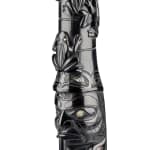-
Artworks
CHRISTIAN WHITE (1962-) OLD MASSET, HAIDA GWAII
Eagle Clan Ancestress Model Totem Pole, 2014argillite, opercular shell, abalone, and catlinite, 14.75 x 4.5 x 4.75 in (37.5 x 11.4 x 12.1 cm)
titled, signed with artist's stylized initials, dated, and inscribed, "Eagle Clan / Ancestress / CW 2014 / Haida Gwaii".LOT 34
ESTIMATE: $25,000 — $35,000
PRICE REALIZED: $72,000.00
A world record for the artist at auctionFurther images
-
(View a larger image of thumbnail 1
)

-
(View a larger image of thumbnail 2
)

-
(View a larger image of thumbnail 3
)

-
(View a larger image of thumbnail 4
)

-
(View a larger image of thumbnail 5
)

-
(View a larger image of thumbnail 6
)

-
(View a larger image of thumbnail 7
)

-
(View a larger image of thumbnail 8
)

-
(View a larger image of thumbnail 9
)

-
(View a larger image of thumbnail 10
)

Born in 1962, Christian White is among the most celebrated Haida artists of this generation. He began carving argillite at a young age under the guidance of his father, Morris...Born in 1962, Christian White is among the most celebrated Haida artists of this generation. He began carving argillite at a young age under the guidance of his father, Morris White and he has been a self-supporting artist since the age of seventeen. White has been an active participant in all aspects of Haida culture including language, ceremonies, and cultural commissions and he has carved numerous totem poles for sites on Haida Gwaii. A small collection of his pieces, all produced before the age of twenty, was donated to the Saahinda Naay (Haida Gwaii Museum) in Skidegate, Haida Gwaii. When White was twenty-two, a Raven Dancing sculpture by him was acquired by the UBC Museum of Anthropology’s permanent collection. His definitive style includes fine details, an elaborate use of inlays, and a narrative style that captures a specific moment in time rather than a static rendering of a myth. An ambidextrous carver, Christian White has the ability to carve both sides towards the middle.
In the time when Raven dominated the Northwest Coast, he took a supernatural being named Ts’ililaakuns for his wife and brought her to Haida Gwaii, where they lived near what is now called Milbanke Sound on the southern coast. A complicated family tree emerged linking into the families of other supernatural beings including Volcano Woman, a recluse who lived in the forest with all the creatures as her children. Ts’ililaakuns became the Ancestress for the Eagle Clan. She is depicted holding a staff and with a labret in her bottom lip as signs of nobility and status. The frogs reference the creatures that were needlessly killed and revenged by Volcano Woman, who rained lava down upon their village thus reshaping the islands.
Gary Wyatt
References: For major argillite works by the artist see Daina Augaitis et al., Raven Travelling: Two Centuries of Haida Art, (Vancouver: Vancouver Art Gallery / Douglas & McIntyre, 2006, cats. 17, 48. See also Ian M. Thom, Challenging Traditions: Contemporary First Nations Art of the Northwest Coast, (Vancouver: Douglas & McIntyre, 2009), pp. 158-161.Provenance
Collection of John and Joyce Price, Seattle. -
(View a larger image of thumbnail 1
)
Join our mailing list
* denotes required fields
We will process the personal data you have supplied in accordance with our privacy policy (available on request). You can unsubscribe or change your preferences at any time by clicking the link in our emails.










